| ◀ Previous | TOC | Next ▶ |
Macroscopic Balance
\begin{align*} {\bf \text{rate of } (\text{amount change})} &= {\bf \text{rate of }( \text{input} - \text{output}} \\ & \quad + {\bf \text{production} - \text{consumption} )} \end{align*}
Models with Homogeneous Differential Equaitons
Example 1 (A tank reactor, batch operation)
Consider a tank containing \(V\) \(\mathrm{[m^3]}\) of water,
which in turn contains \(C_0\) \(\mathrm{[mol \ m^{-3}]}\) of component A.
Suppose that the concentration \(C\) \(\mathrm{[mol \ m^{-3}]}\) of A decreases at the rate
\begin{equation} \frac{dC}{dt} = - kC \tag{1} \label{eq: example 1 problem} \end{equation}
where \(k\) \(\mathrm{[s^{-1}]}\) is the rate constant.
Find \(C(t)\).
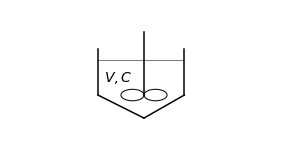
Example 1, solution
Balance, rate of
\[{\bf \text{amount change}} = \color{gray}{\text{input} - \text{output}- {\text{production}}}- {\bf {\text{consumption}}}\]\[V \frac{dC(t)}{dt} = - V \left(k C\right)\]The equation (1) is a homogeneous constant-coefficient first order linear equation, and its solution is
\[C(t) = C_0 \exp(-kt)\]
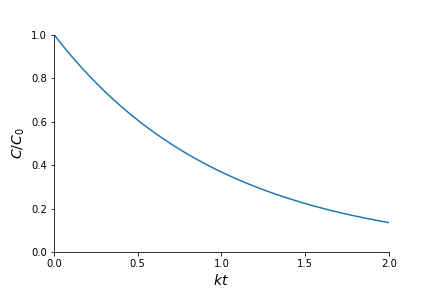
Example 2
Consider a tank containing \(V\) \(\mathrm{[m^3]}\) of water.
We feed the tank with \(F\) \(\mathrm{[m^3 ~ s^{-1}]}\) of water with the concentration \(C_\mathrm{in}\) \(\mathrm{[mol ~ m^{-3}]}\) of component A.
Water flow out from the tank at the same rate \(F\) (drain \(D=F\)).
Let the initial concentration of component A in the tank is \(0\).
Find the change of the concentration of component A.
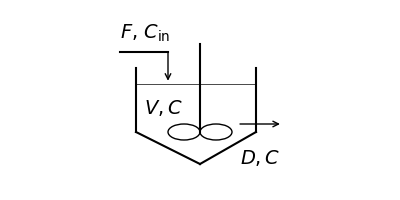
Example 2, solution
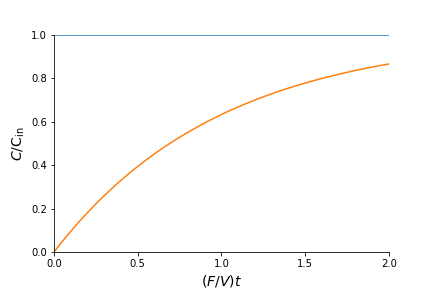
Example 3
For the tank reactor in Example 2, find \(C(t)\) when the component A in tank decreases at the rate
\[\frac{dC}{dt} = - kC\]
Example 3, solution
This differential equation can be converted into the following form.
whose solution can be found easily,
\(a\) and \(\kappa\) have to satisfy the following
\[\kappa = \frac{1}{V} \left(Vk + F \right)\]\[\kappa a = \frac{1}{V} FC_\mathrm{in}\]With there equations, the differential equation is turned into
\[\frac{d}{dt} \left( C - \frac{F/V}{k + F/V} C_\mathrm{in} \right) = - \left(k + \frac{F}{V}\right) \left(C - \frac{F/V}{k + F/V}C_\mathrm{in}\right)\]The initial concentration \(C_0 = 0\), thus, the solution is
\[C(t) = \left(- \frac{F/V}{k + F/V} C_\mathrm{in}\right)\exp\left\{-\left(k+ \frac{F}{V}\right)t\right\} + \frac{F/V}{k + F/V}C_\mathrm{in}\]
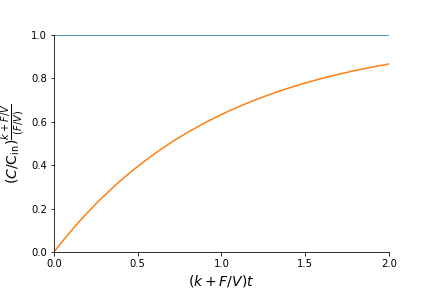
Models with Nonhomogeneous Differential Equaitons
Example 4
In Example 2, what if \(C_\mathrm{in}\) is a function of \(t\), say
\(C_\mathrm{in} = c\exp (-t)\)
where \(c\) is a constant.
Example 4, solution
which is a first order linear (ordinary) differential equation.
Integrating factor:
\[\mu(t) = e^{\int^t \frac{F}{V} \, dt} = e^{tF/V}\]The general solution has the following form:
\[y = \frac{1}{\mu(t)} \left\{\int \mu(t) \frac {cF}V e^{-t} \, dt + A\right\}\]
The integral in the right hand side is evaluated as
\begin{align*} \int \mu(t) e^t \, dt &= \int e^{tF/V}e^{-t} \, dt % \\ & = \int e^{t(F/V - 1)} \, dt \\ & = \frac1{F/V - 1} e^{t(F/V -1)} \end{align*}
The general solution \(y\) is
\[y = \frac{1}{e^{tF/V}}\left\{ \frac{cF}{V} \frac{1}{F/V - 1} e^{t(F/V - 1)} + A\right\}\]From \(C_0 = 0\), we have \(A\) as
\[A = - \frac{c}{1 - V/F}\]The solution satisfying the initial condition is
\[C(t) = \frac{c}{V/F - 1} \left(e^{-tF/V} - e^{-t}\right)\]
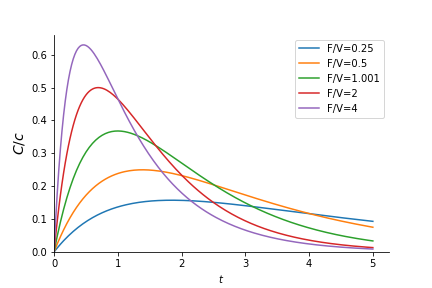
Exercise 1
In Example 4, what if
\[C_\mathrm{in} = c(1 + \sin t)\]where \(c\) is a constant.
| ◀ Previous | TOC | Next ▶ |